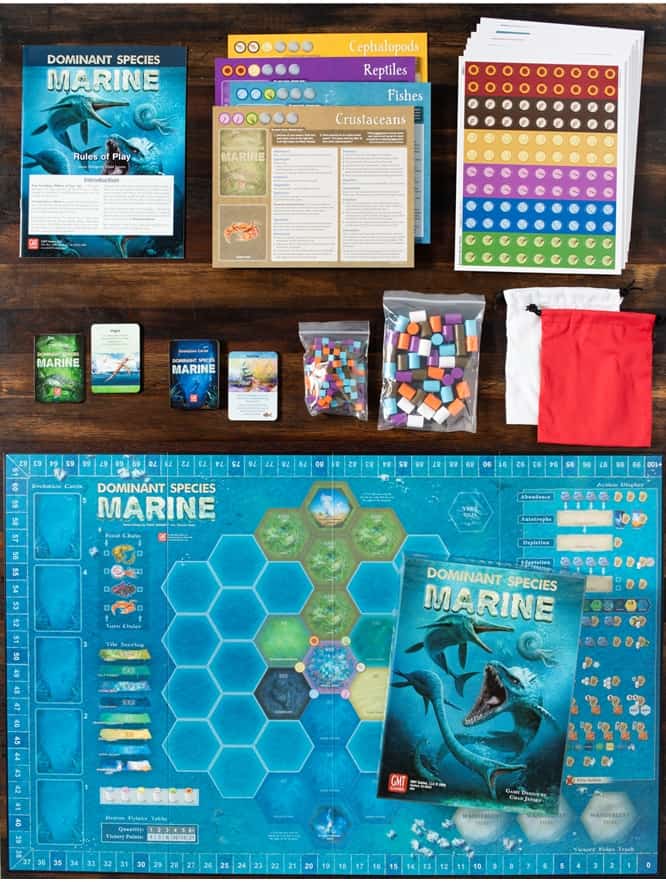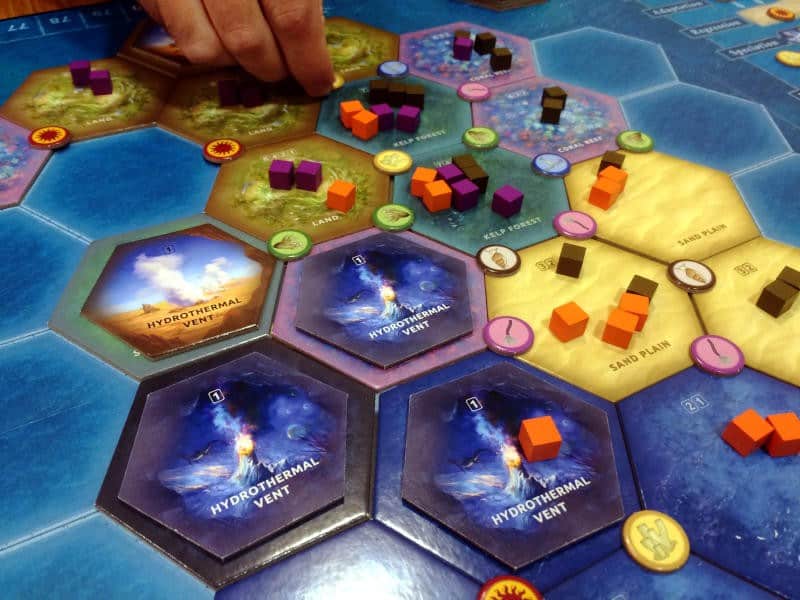Dominant Species: Marine is an standalone board game based on the highly acclaimed board game Dominant Species, and it introduces several significant changes and thematic shifts compared to the base game.
While both games share the core concept of species survival and adaptation in a dynamic environment, Marine takes the action underwater, adding a new layer of complexity. In Dominant Species: Marine, players step into the roles of marine species, vying for dominance and survival in the evolving oceans of prehistoric Earth.
One key distinction is the environment itself. In the base Dominant Species game, the action is set on land, with species evolving and competing for control over various habitats.
Dominant Species: Marine, on the other hand, shifts the focus to aquatic ecosystems, introducing new elements like currents and deep sea tiles. This expansion also incorporates a unique element called “competition,” where players actively push each other out of regions.
While the core gameplay mechanics and objectives remain similar, Dominant Species: Marine offers a fresh thematic experience and introduces new strategies and challenges, making it a compelling addition for fans of the original game looking for a different flavor of prehistoric survival.
What’s included in Dominant Species: Marine

- Game Board: Represents the aquatic world divided into hexagonal regions.
- Element Markers: Represent Earth, Water, and Fire elements that determine turn order.
- Species Boards: These are player boards where you track your species and their traits.
- Action Pawns: These represent the actions your species can perform.
- Element Markers: Determine the element for the round.
- Survival Cards: Indicate the available actions and events for the round.
- Scoring Markers: Track the score of each player.
- Scoring Tokens: Represent elements and dominance in specific regions.
- Food Tokens: Represent food sources.
- Sea Creatures: Represent the current inhabitants of the oceans.
- Competition Markers: Used for competitive interactions.
How to play Dominant Species: Marine

Dominant Species: Marine shares many rules with the base game, so if you have played that, you should be familiar with most of the ruleset. The new additions are the introduction of underwater ecosystems and competition dynamics into the game. Nevertheless, here’s a detailed guide on how to play Dominant Species: Marine.
Setup
- Place the game board in the center of the table, and set up the elements track, element markers, and food tokens as in the base game.
- Each player receives a species board, action pawns, and survival cards as in the base game.
- Shuffle the competition markers and place them face down.
- Randomly seed the board with food tokens and sea creatures following the setup chart.
- Choose a starting player, who takes the lowest numbered element marker.
Rules for Dominant Species: Marine
Dominant Species: Marine is played over several rounds, each consisting of multiple phases, much like the base game. Here’s a detailed breakdown of the gameplay:
1. Element Turn Order Phase:
- Players take turns based on the element markers’ order (Earth, Water, Fire). The lowest-numbered element goes first.
2. Execution Phase:
- In turn order, players place one action pawn on a survival card or action space on the board. Survival cards allow various actions, while board actions include migration, adaptation, competition, and glaciation.
3. Board Actions Phase:
- Resolve the actions on the board from top to bottom. These actions include:
- Migration: Move species to adjacent regions.
- Adaptation: Add or remove traits from species.
- Competition: Determine control of regions.
- Glaciation: Remove food from the board.
4. Survival Cards Phase:
- In element order, players resolve actions on survival cards and gain food, traits, or other advantages.
5. Competition Phase:
- Reveal and resolve the top competition marker. This marker specifies a region where competition occurs, and players compete for dominance in that region.
6. Element Marker Advancement:
- Move the element markers up one space, adjusting the turn order.
7. Scoring Phase:
- Check the scoring tiles and award points based on specific criteria (e.g., controlling regions, surviving in hostile environments).
8. Advance the Epoch Marker:
- Move the epoch marker forward to the next round. The game progresses through multiple epochs.
9. End of Round:
- After the final epoch, calculate final scores, including points for controlled regions, remaining food, and other bonuses.
Winning the Game: The player with the highest total score at the end of the game wins.
For the official rules, see the link below:
Strategies for Dominant Species: Marine

While some strategies from the base game remain relevant, others need to be adapted to the aquatic environment. Here are some strategies and comparisons between the two games:
1. Adaptability and Planning:
- Adaptability is crucial in both games, but it takes on a new dimension in Dominant Species: Marine due to the shifting nature of the oceans.
- In the base game, players adapt to changing habitats on land. In Marine, the focus is on adapting to fluctuating sea levels, currents, and deep sea regions. Consider the impact of glaciation and the movement of sea creatures.
2. Food Sources:
- Food management remains a key element in both games. However, in Dominant Species: Marine, you must pay attention to both sea creatures and food tokens, which can move and disappear rapidly.
- Prioritize controlling regions with food sources and plan migrations to access valuable sea creatures.
3. Element Dominance:
- In the base game, dominance in elements (Earth, Water, Fire) is essential. In Marine, the focus shifts to dominance in specific habitats and regions, such as deep sea, kelp forests, or polar regions.
- Dominating these aquatic regions can provide a significant advantage in Dominant Species: Marine, just as element dominance does in the base game.
4. Competition and Control:
- Competition is a central element in both games, but Dominant Species: Marine introduces the competition phase, where players compete for control of specific regions.
- Adapt your strategies in Dominant Species: Marine to excel in competitions, as these can be a significant source of points and dominance.
5. Timing:
- Timing your actions is crucial in both games. In Dominant Species, timing migrations and adaptations can secure control of regions. In Dominant Species: Marine, timing migrations and adaptations to coincide with changing sea levels and food availability is essential.
6. Resource Management:
- Resource management is paramount in both games. In Dominant Species, it involves managing elements and elements markers. In Dominant Species: Marine, it extends to efficiently using food tokens and sea creatures as resources.
- Plan your species’ diets and migrations to optimize food collection.
7. Dominance Cards and Traits:
- Dominance cards and traits continue to be powerful tools in Dominant Species. Traits that allow your species to excel in specific aquatic regions or dominate competitions can be highly advantageous.
8. Endgame Scoring:
- In both games, endgame scoring is a significant source of points. Pay attention to the available scoring tiles and adapt your strategies accordingly in the late game.
9. Interaction with Opponents:
- Both games involve player interaction and competition. Be aware of your opponents’ strategies and adjust your own to counter their moves when necessary.